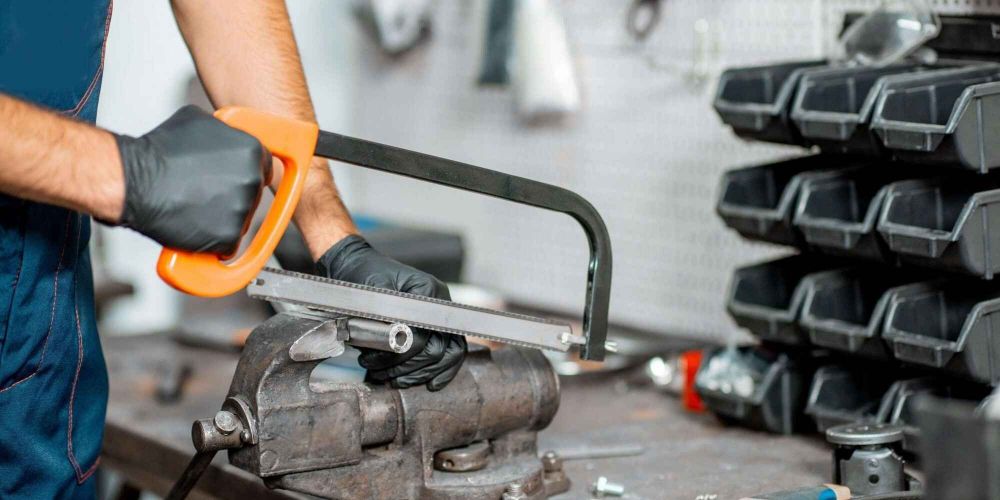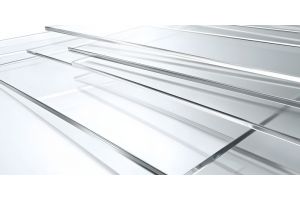
Cutting metal by hand is an achievable task with the right tools and technique. An inexpensive hacksaw is all you need to cut through metal rods, sheets and pipes with patience and effort. Follow these steps to cut metal safely and efficiently.
Selecting the Right Hacksaw for Cutting Metal
When it comes to cutting metal, having the right hacksaw blade is key. Hacksaw blades come in different "teeth per inch" (TPI) options, like 14, 18, 24, and 32. For metal 2mm (1/16") and thicker, use a blade with 14 to 18 TPI. For thinner metal, choose 24 or 32 TPI.
Selecting the Right Blade
For cutting most metals, a blade with 14 or 18 TPI (teeth per inch) is a good place to start. These coarser blades cut through metal quickly, while for cutting thin sheet metal or metal pipes, a 24 or 32-TPI blade may be better since the finer teeth provide a smoother cut.
You'll also want to consider the blade's pitch, which refers to the angle of the blade's teeth. A blade with a raker pitch has teeth that cut on the push and pull stroke, allowing for faster cutting. But for cutting curves, a blade with a regular or variable pitch works better since the teeth cut in alternating directions.
Blade length is also important. In general, choose a blade that is at least 2 to 3 inches longer than the metal you want to cut. Longer blades provide more control and are less likely to bend or break. However, for cutting curves or shapes, a shorter blade may provide more control.
Choosing the Correct Blade for the Metal Type
Choosing the right hacksaw blade for the metal you want to cut is key to success. The blade needs to be harder than the metal, otherwise, it won’t cut efficiently and can become dull quickly.
For softer metals like aluminium, copper or thin mild steel sheets, use a blade with 14 to 32 teeth per inch. The more teeth, the smoother the cut will be. These metals don’t require as much force to cut, so a blade with more teeth works well.
For harder metals such as mild steel, iron or galvanised pipe, a blade with 6 to 14 teeth per inch is ideal. The fewer teeth require more pressure but can handle the denser, more rigid metals. An 8 or 10-TPI blade is a good all-purpose choice for most DIY metal cutting jobs. If cutting thicker pieces of hard metal, consider going down to 6 or 8 TPI.
Bi-metal or carbon steel blades can cut through the most common metals. For stainless steel or other alloys, use a blade specifically designed to cut that metal. These often have added cobalt or tungsten carbide. Be prepared to apply plenty of pressure and make multiple passes.
Using the proper blade for your metal type will make the cutting process easier and help you get clean, precise cuts. Start with a coarser blade and you can always switch to a finer-toothed blade for finishing cuts or curves.
Hacksaw TPI Recommendations
| TPI Range | Grade | Common Uses/Metals |
|---|---|---|
| 14-18 TPI | Coarse | Thin-walled tubing, sheet metal, conduit, brass, aluminum |
| 20-24 TPI | Medium | Medium thickness steel, copper, bronze, plastic |
| 24-30 TPI | Fine | Thick steel, stainless steel, heavy-duty metal cutting |
| 30-32 TPI | Superfine | Extremely fine cutting in very thin materials, precision work |
Proper Hacksaw Cutting Technique
To cut metal properly and safely with a hacksaw, follow these steps:
Secure the workpiece
Clamp the metal securely in a vice or clamp to prevent it from moving as you cut. This will make cutting much easier and safer. If clamping isn’t possible, have a friend help brace and support the workpiece.
Use a cutting fluid (optional)
For cutting harder metals like steel, applying cutting fluid can help. Cutting fluid reduces friction and heat, extending blade life. Apply the fluid along the cutting line before and during cutting. For softer metals, cutting fluid is typically not needed.
Use firm, steady pressure
Hold the hacksaw at a 90° angle and keep your arm steady. Apply firm and even pressure as you push the saw forward and pull it back. Let the saw do the work—don't force it. Maintain a steady pace and speed. Rushing can cause you to bend or break the blade.
Cut on the pull stroke
For the most effective cutting, apply pressure on the pull stroke as you draw the saw back towards you. Release pressure on the push stroke. This will prevent the saw from getting stuck in the cut. Continue alternating pull and push strokes until you cut through the metal.
Deburr edges (optional)
Once cut, you may want to deburr the edges by filing off any sharp burrs or edges. Be very careful, as the cut edges and burrs can be extremely sharp. Wear work gloves and file slowly and carefully.
Following these basic steps will ensure you get clean, accurate cuts when using a hacksaw to cut metal. Be safe, take your time, and let the saw and blade do the work. With some practice, you'll be cutting metal in no time.







